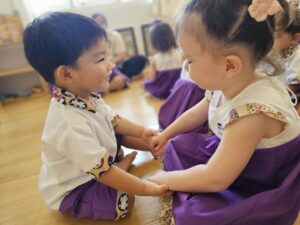Knowing what is going to happen next is the key to enhancing children’s security and emotional stability.
Not only does it reinforce their trust that caring adults will provide what they need, but it frees up their emotional tank and allows them to do the important “work” of childhood including playing, exploring and learning, said House on the Hill Principal, Marilyn Ow.
4 Beautiful Locations Islandwide
What is a routine and how do you use them for positive outcomes?
Routines are like instructions that guide a child’s actions toward a specific goal, and they can be used for many reasons, but two of the most important are ensuring children’s health and safety, and helping children learn positive, responsible behaviour.
You can support children to learn to manage their behaviour when you:
- View children as capable and competent and approach situations from a strengths-based perspective.
- Ensure they feel secure and let them know that you are there to help and support them.
- Provide positive reinforcement, encouraging a strong sense.
For example, at House on the Hill, the children wash their hands before they have a snack. Once they have finished their snack, the children take any leftover food and their bowls to the cart and then wash their hands. Our simple handwashing routine is a simple yet effective example of how routines can positively impact young children’s development.
Why are routines so important for young children?
Within early years settings it’s crucial that all teachers have a good sense of routine and how that routine benefits children. Research has shown the importance of routines and evidence linking routines to positive developmental outcomes in children, covering:
- Security and Stability: Routines provide a predictable framework for the day. Children know what to expect, which reduces anxiety and fosters a sense of security. This allows them to feel safe exploring and learning within that framework.
- Self-Regulation: Consistent routines help children develop self-regulation skills. They learn to anticipate transitions and manage their emotions accordingly. Following routines builds a sense of accomplishment, boosting confidence and self-esteem.
- Social-Emotional Development: Routines create a predictable social environment. Children learn to take turns, share, and cooperate within the established structure. This fosters positive social interactions and emotional intelligence.
- Cognitive Development: Routines help children develop memory and sequencing skills. They learn to predict what comes next and can mentally prepare for transitions. This repetitive structure strengthens cognitive pathways.
- Academic Skills: Consistent routines establish a foundation for future learning. Children become accustomed to focused activities, transitions, and following instructions. This prepares them for more structured academic environments.
- Physical and Mental Health: Predictable routines promote healthy sleep patterns and eating habits. Knowing what to expect throughout the day reduces stress, contributing to overall well-being.
How do routines help children learn?
Routines provide children with a context for learning. Through effective use of routines and transitions, children learn how their world is organised and what they need to do in order to interact successfully in it. For example, after they wake up, they need to get dressed and have breakfast before getting ready to go to preschool.
Once they arrive at school they will:
- Say goodbye to their parent/caregiver.
- Walk through the door to get their temperature checked and wash their hands.
- Say good morning to the teachers.
- Walk to their classroom, put their shoes and bag in their respective cubby holes, and remove their water bottle to take into class.
- Next is free play before sitting down together as a group.
Routines provide children with a sense of continuity throughout the day and let them know what to expect next. When planned properly, routines also offer opportunities for children to learn methods associated with math and sequencing, including:
- Following an ordered sequence of activities
- Determining relationships between elements
- Counting
- Making simple calculations
Participating in common daily routines can also have a powerful effect on children’s language development, with many day-to-day activities providing excellent prompts for discussion. Teachers and parents can name items being used in the routine, discuss each action as it is being done and talk about what comes next.
How does House on the Hill demonstrate this within our school?
Arrival time has become a significant part of our school’s everyday morning/afternoon routines and acts as a significant means of support for both families and children with their transitions between home and school.
When children arrive in the morning it can make them feel calm and reassured to see a familiar teacher’s face as well as some of their favourite activities.
Self-help skills are also encouraged throughout the school, particularly as your child progresses into older rooms.
Learning to prepare their own healthy snacks, setting the table for meals and washing up their own plates after eating are some of the ways we help children develop a sense of agency.
Mealtimes in the school provide a solid base for children to begin engaging in positive interactions with each other as well as carry out meaningful conversations in which they can get to know each other more.
In essence, routines are incredibly important for young children. As children grow and learn, routines help them to develop a sense of security and feel safe in what we often refer to as a stable learning environment. In other words, routines help integrate children’s learning with an “organised connection.”
When children are in a good routine, not only do they feel confident and in control, but they also learn to develop positive social skills and a sense of satisfaction in being able to do things for themselves.








